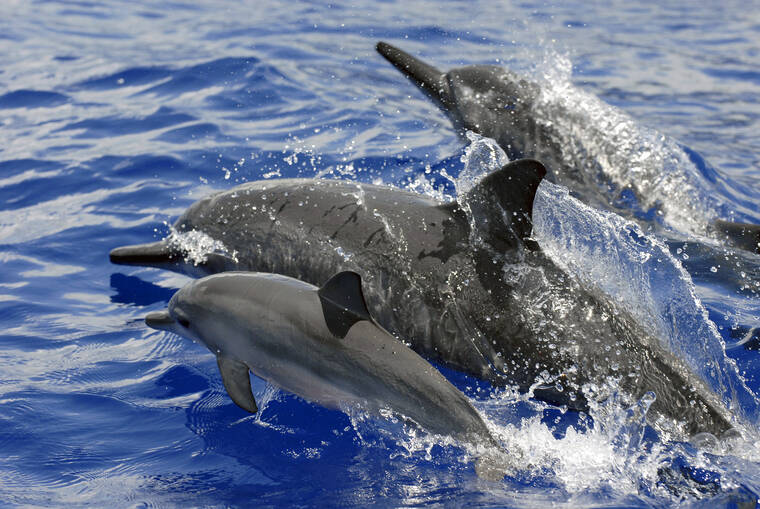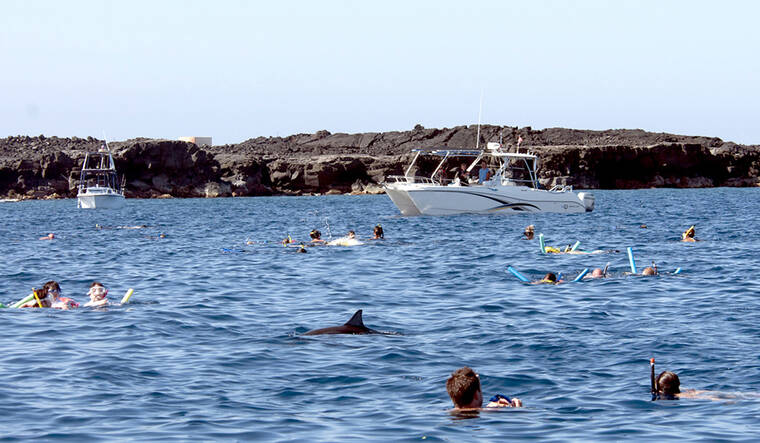Swimming with Hawaiian spinner dolphins will be a thing of the past come next month.
The National Marine Fisheries Service Tuesday published its final rule banning the popular practice in Hawaiian waters effective Oct. 28 saying the regulation under the Marine Mammal Protection Act is necessary to protect the nocturnal animals from those seeking encounters with the playful species.
Swimming with Hawaiian spinner dolphins (Stenella longirostris) is a popular activity among tourists and residents in Hawaii that generates millions annually. A host of companies offer tours that take swimmers to areas frequented by dolphins with the aim of giving them an opportunity to get in the water with the animals.
Hawaii’s wild dolphin tourism industry in 2013 generated an estimated $102 million on Hawaii Island and Oahu with dolphin viewing generating $58.6 million and swimming $39.2 million, according to a study of 77 dolphin tour companies by researchers with the University of Hawaii at Manoa, Duke University and York University published in August 2020 in Frontiers of Marine Science.
According to the study, an estimated 524 to 761 Hawaiian spinner dolphins, or naia, reside in waters around Kailua-Kona and 329 around Oahu. They’re frequently seen close to shore and are known for their tri-colored pattern, relatively small size at 5-6 feet and ability to spin while leaping in the air.
Dolphin tourism off Kailua-Kona accounted for approximately 43%, or $44.1 million, of the total annual revenue with about $13.5 million coming from dolphin swims and $26.3 million from watches.
The rule, published Tuesday in the Federal Register, prohibits swimming with or getting within 50 yards (45.7 meters) of a spinner dolphin that is within 2 nautical miles of the shore of the main Hawaiian Islands. The rule applies to persons, boats, canoes, stand-up paddleboards, drones or other objects.
That means being within 1/2 of a football field of the mammal, by any means, including swimming or intercepting by boat the mammal’s path, would be outlawed — statewide.
“Although unauthorized take of marine mammals, including harassment of spinner dolphins, already is and continues to be prohibited under the MMPA throughout their range, the purpose of this regulation is to identify and prohibit specific human activities that result in take (including harassment) of Hawaiian spinner dolphins, and thus reduce disturbance and disruption of important Hawaiian spinner dolphin behaviors in areas where human-dolphin interactions are most likely to occur,” the rule reads. “This regulation is expected to reduce take of Hawaiian spinner dolphins and the impact of human viewing and interaction on these animals in the main Hawaiian Islands (MHI).”
NOAA, under the auspices of which the National Marine Fisheries Service falls, first began efforts to create rules aimed at reducing impacts by implementing time-area closures in spinner dolphin resting bays with the publication of an advanced notice of proposed rulemaking in 2005. In August 2016, NOAA proposed rules that would make it illegal to approach or swim with Hawaiian spinner dolphins in Hawaii. A final EIS for the rule was published this summer.
With the publication Tuesday of the final rule, NOAA announced a proposed rule to establish time-area closures at four sites in West Hawaii and one on Maui. The proposed rule would establish mandatory time-area closures of Hawaiian spinner dolphins’ essential daytime habitats from 6 a.m. to 3 p.m. daily in areas of Kealakekua Bay, Honaunau Bay, Kauhako Bay (Ho‘okena), and Makako Bay on the Big Island, and La Perouse Bay on Maui.
Comments will be accepted on the proposal through Dec. 27. The proposed rule can be viewed at https://bit.ly/3ifySw3.
NOAA also is proposing a regulation that would prohibit entering certain areas between 6 a.m. and 3 p.m. in parts of the Big Island and Maui that are considered essential daytime habitats for spinner dolphins.
Hawaiian spinner dolphins are nocturnal, hunting at night and coming into shallow, near-shore waters to socialize, nurture their young, and rest in preparation for nightly foraging.
A 2018 study by doctoral student Julian Tyne that assessed the impact human exposure has on spinner dolphins off the Big Island’s leeward coast found that spinner dolphins off the Kona Coast were exposed to human activity within 100 meters 82% of the time when they were in resting bays, with only about 10 minutes of reprieve between interactions.
While the swim-with and 50-yard approach prohibition is expected to reduce frequency of human and spinner dolphin encounters, the specific essential daytime habitats have been a focused target for dolphin-directed activities where animals that use these areas are exposed to intense levels of disturbance.
“These time-area closures are necessary and appropriate under the MMPA to reduce take of individual animals in their daytime resting areas. Disturbances to dolphins’ daily behavioral patterns in essential daytime habitats may result in ‘take,’ as defined and prohibited under the MMPA and its implementing regulations,” the proposed rule reads. “The chronic nature of these problems in Hawaii and observed changes to spinner dolphin behavioral patterns over time are a cause for concern and require management action to prevent take and provide sufficient protection for Hawaiian spinner dolphins at essential daytime habitats.”


